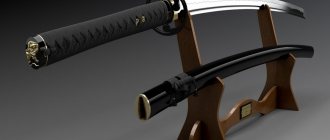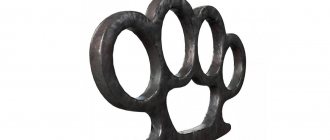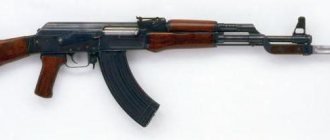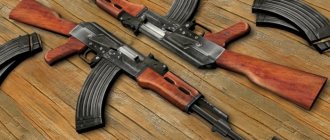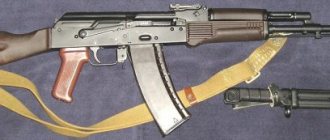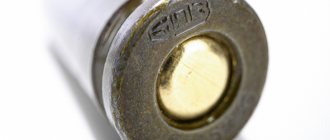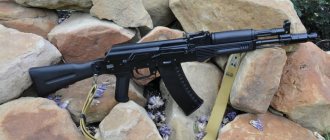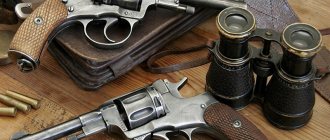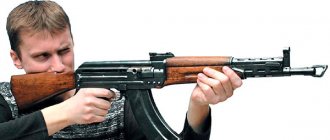Even during the First World War, it became clear that the density of fire of the rifle squad created with the help of rifles and carbines was insufficient.
There was a need for individual infantry soldiers to have personal rapid-fire weapons.
This problem was solved with the creation of submachine guns and machine guns. The Second World War gave rise to many different designs of automatic weapons, among which the Shpagin submachine gun (PPSh) should be noted.
However, towards the end of the war, a need arose to create new weapons, which was solved by the introduction of the Kalashnikov assault rifle.
How the first Kalashnikov assault rifle appeared
In 1943, the Technical Council conducted a study of the German MKb.42(H) assault rifle, created for the Wehrmacht 7.92x33 mm cartridge. The German experience and the experience of the American designers who created the M1 Carbine were considered successful.
Soviet designers were faced with the question of creating similar weapons.
After several attempts to create a universal cartridge, experts settled on the 7.62x39 caliber. Its creators were designers N.M. Elizarov and B.V. Semin. Designer Sudaev developed the AS-44 assault rifle for this cartridge, which went into small series.
The machine passed army tests, but the military recommended modifying the design, reducing the overall weight of the machine. The death of Sudaev stopped work on this design.
The need to create weapons required a new round of the competition, at which the first Kalashnikov assault rifle was shown in 1946. Following the results of two stages, this machine was declared unsuitable, but the designer managed to obtain the right to modify it.
After modification in 1947, the machine still did not meet the necessary requirements, but it was better than the others presented in the competition.
Kalashnikov was sent to Izhevsk, where, after modification, the famous machine gun of the 1947 model appeared, which for decades determined the development of automatic weapons on the planet.
The question of who invented the Kalashnikov assault rifle does not have as clear an answer as it seems.
It's hard to believe that a not very competent Komsomol member was able to create an effective military weapon.
Designer Mikhail Timofeevich Kalashnikov claimed that the idea of creating a new machine gun came to him after reading a book about small arms. But it’s one thing to think, and quite another to create it.
On the other hand, as a Komsomol leader, Mikhail Timofeevich was quite suitable for the role of a wedding general.
Let us remind you that this is exactly what Alexey Stakhanov became earlier, to whom all the work of the brigade was credited.
The layout and technical solutions used in the Kalashnikov Ak-47 assault rifle are in many ways similar to the German MP-38 submachine gun, designed by Schmeisser, as well as the MP-40 created by a group of German specialists.
AKS-74
For the Airborne Forces, a modification with a folding stock was traditionally made, although this time it was retracted to the left along the receiver. It is believed that this decision was not very successful: when folded, the machine gun was wide and rubbed the skin when worn behind the back. When worn on the chest, it became inconvenient if it was necessary to fold back the butt without removing the weapon.
A leather cheek muff appeared on the upper side of the butt; it protected the shooter’s cheek from freezing to a metal part in winter conditions.
Automatic model 1946
The Kalashnikov AK-46 assault rifle itself was a very crude and intermediate version.
It was rather a transitional model from the Shpagin submachine gun, the most common at that time in the Soviet (Red) Army, to the weapon that became familiar to everyone under the name AK-47.
It contained many shortcomings, but it was a necessary step towards the subsequent constructive breakthrough. Let's look at this weapon in more detail.
What was the circuit and device
Since the original machine gun was quite different from the model we are used to, it is interesting to know what the differences were:
- The cocking handle was located on the left, not on the right. The location was changed at the suggestion of the state commission, since when moving by crawling, the handle would rest against the stomach;
- Availability of a separate fuse;
- The lever for converting firing from single to burst firing was a separate device;
- Folding trigger mechanism on a pin.
The bolt frame with a rigidly fixed gas piston appeared during modifications at the Kovrov plant before the second round of the competition.
Its appearance dramatically improved the tactical and technical characteristics, so to the question of how the Kalashnikov assault rifle works, the answer is simple - due to the energy of the exhausted powder gases.
A similar device could have been copied from the Bulkin machine gun that participated in the competition.
The structure of the machine gun for burst firing was changed - the safety was combined with the transfer lever, which significantly simplified the design, making it clearer for soldiers.
What technical characteristics did the AK-46 have?
- Cartridge caliber 7.62×41 model 1943;
- Barrel length 450 millimeters;
- The total length of the machine is 950 millimeters;
- Magazine capacity of 30 rounds + 1 round in the barrel;
- The weight of the machine gun, excluding the weight of cartridges, is 4.328 kilograms;
- The target firing range is 0.8 kilometers.
AK-74M
This machine gun is a deep modernization of the weapon adopted for service in 1974. Having retained all the best qualities inherent in Kalashnikov assault rifles, the AK-74M acquired a number of new ones that significantly improved its combat and operational characteristics.
The main feature of the new model was a folding plastic stock, replacing the metal one. It was lighter than its predecessors and similar in design to the permanent plastic stock of the AK-74 produced in the late 1980s. When worn, it clings less to clothing and does not cause discomfort when shooting in low or high temperature conditions.
The handguard and the barrel lining of the gas tube of the machine gun were made of glass-filled polyamide. In terms of heat transfer, the new material was almost no different from wood, which eliminated hand burns during prolonged shooting. Longitudinal ribs on the fore-end made it easier and more secure to hold the weapon during aimed fire.
How the AK-47 and AKS were created
After the second round, held in 1946, the commission made a decision that stated that none of the machines submitted to the competition, even after modifications, met the required characteristics.
The machine gun created by designer Bulkin came closest to the necessary requirements in terms of tactical and technical characteristics (TTX). However, for reasons of simplicity and accessibility of production, and maybe for some other reasons, it was decided to modify the Kalashnikov assault rifle.
To bring the weapon to the required characteristics, the Kalashnikov-Zaitsev design team was sent to Izhevsk. At that time, a group of famous German designers worked at the Izhevsk arms factory.
Among them was the famous Hugo Schmeisser, who at one time designed many types of automatic and assault weapons. His weapons were successfully used by the Wehrmacht on various fronts of the Second World War.
It is unknown whether the Germans collaborated with the creators of the new machine gun, but it was very different from the one provided earlier.
The machine gun itself was originally produced with a wooden butt. However, for special troops this was inconvenient, primarily due to the length of the weapon, so a modification was created for them that reduced the dimensions of the product.
The wooden stock was replaced by a metal one, and the latter could be folded. This modification of the weapon was called the folding Kalashnikov assault rifle (AKS). It was possible to go into battle with this weapon straight after a parachute jump, without unfolding the butt.
What tactical and technical characteristics did the AK-47 have?
Let's consider the performance characteristics of the Kalashnikov assault rifle of the 1947 model. It should be noted here that the table itself is given for the basic model. The folding version is practically no different from it, with the exception of weight. It is 400 grams lighter and 2 millimeters shorter.
- The caliber of the weapon is 7.62 millimeters.
- The cartridge used for shooting is 7.62x39 mm;
- The total length of the machine is 870 millimeters;
- The length of the stem is 415 millimeters;
- The weight of the machine gun excluding cartridges is 4.3 kilograms;
- The total mass of cartridges is 576 grams;
- Total weight including cartridges - 4.876 kilograms;
- The maximum firing range is 0.8 kilometers;
- Rate of fire - 600 rounds per minute;
- Burst rate of fire - 400 rounds per minute;
- Rate of fire with single shots - from 90 to 100 rounds per minute;
- The initial bullet speed is 715 m/sec (2500 km/h);
- The number of cartridges in the magazine is 30 pieces.
Ammunition and its characteristics
The 7.62×39 mm caliber cartridge (model 1943) is a universal Soviet ammunition that is used not only in Russia, but also in many countries of the Middle East and Africa. Among the undeniable advantages of the cartridge, the most common is a fairly heavy bullet, which retains its energy even at long distances. The technical characteristics of the 7.62 mm projectile are as follows:
| Characteristic | Parameter |
| Nominal caliber | 7.62 mm |
| Real caliber | 7.92 mm |
| Case length | 39 mm |
| Sleeve width | 7.62 mm |
| Bullet weight | 12.6 g |
| Powder charge mass | 1.75 g |
| Cartridge weight | 20 g |
| Power | 2206 J |
| Initial bullet speed | 750 m/s |
There is a fairly common myth circulating on the Internet that a bullet fired from an AK-47 will pierce a metal rail. This is, of course, not true. However, the projectile is capable of penetrating a brick wall 10 cm thick when fired from a distance of up to 100 meters. When fired from a machine gun, the projectile completely penetrates concrete up to 15 mm. So the ammunition definitely doesn’t take up the power, but it still won’t penetrate thick metal.
How did the modernized Kalashnikov assault rifle (AKM) appear?
In the early fifties, designer German Korobov presented a new model of infantry weapon, the TKB-517 assault rifle, to experts and army leadership.
This weapon had better accuracy and lighter weight compared to the AK-47. The mere fact that the production of TKB-517 was cheaper meant a lot. Taking into account the best technical and tactical characteristics of the newly introduced model, it was clear that the time had come for a new weapon.
However, the army leadership and the government of the Soviet Union decided not to radically change the production technology (as well as debunk the inflated glory of the designer) and gave Kalashnikov the opportunity to modernize his version of the weapon.
This is how the modernized AKM Kalashnikov assault rifle appeared.
In the new version, the butt was slightly raised compared to the original, which brought the butt resting point on the shoulder closer to the shot line. The target range was increased to one kilometer.
In addition, a light machine gun unified with it, called the RPK, was created on the basis of the AKM.
Is it possible to install a bayonet?
On the first AK-47 models, the installation of a bayonet was not provided. This fact indirectly proves the participation of German weapons designers in the work on weapons.
The fact is that during the Second World War, Nazi weapons did not have the possibility of attaching additional bladed weapons. The German infantryman had to be able to use weapons in such a way as to hit the enemy with a bullet.
Infantry soldiers were simply practically not trained in hand-to-hand combat techniques.
However, later the AK received a blade two hundred millimeters long, which was attached to the gas chamber. It had a double blade and fuller.
The appearance of the AKM also changed the design of additional weapons.
Instead of a double blade, a single blade appeared with a file on the other side.
The length of the blade was reduced to 150 millimeters. The bayonet-knife itself received more possibilities for use in the economic field for the needs of the soldier.
AKS-74U
Following the world fashion of the 1960-70s, the USSR decided to develop a small-sized machine gun that could be used in cramped combat conditions, mainly when shooting at close and medium distances. The next announced competition among designers was won by Mikhail Kalashnikov.
Compared to the AKS-74, the barrel was shortened from 415 to 206.5 millimeters, which is why the gas chamber had to be moved back. This, writes Sergei Monetchikov, entailed a change in the design of the front sight. Its base was made in conjunction with the gas chamber. This design also caused the sight to be moved closer to the shooter’s eye, otherwise the aiming line would be very short. Finishing the topic of the sight, we note that the machine guns of this model were equipped with self-luminous attachments for shooting at night and in conditions of limited visibility.
The greater pressure of the powder gases required the installation of a reinforced flame arrester. It was a cylindrical chamber with a bell (an extension in the form of a funnel) at the front. The flame arrester was mounted on the muzzle of the barrel, on a threaded fit.
The shortened machine gun was equipped with a more massive wooden fore-end and a gas tube receiver; it could use either standard 30-round magazines or shortened 20-round magazines.
To more completely unify the shortened machine gun with the AKS-74, it was decided to use the same butt, which folds onto the left side of the receiver.
How the 1974 AK-74 model came to be
In the early seventies of the last century, the armies of potential enemies (NATO) began to massively switch their automatic weapons from the usual rifle caliber to a lightweight unified cartridge with a caliber of 5.56 millimeters.
There was an urgent need for the armies of the Warsaw Pact countries and the Soviet Union to take a step in the same direction. The 5.45 mm caliber was called upon to replace the rifle cartridge.
It had sufficient destructive power, but was lighter in weight and less expensive to produce. The total weight of the eight wearable ammunition loads has been reduced by 1,400 grams.
The new version of the machine gun has a 100-meter longer direct shot range and a magazine made of durable plastic. Thanks to the new muzzle brake, the accuracy and accuracy of the combat has increased.
Varieties by year
Over more than 70 years of existence of the Kalashnikov assault rifle on the market, a huge number of modifications and variants of this weapon have been released. We present to your attention a list of only the main models, distributed by year:
- AK-47 (1947) - the first version of the Kalashnikov assault rifle;
- AKS (1949) - modification of the AK-47 with a folding stock;
- AKM (1954) - a modernized assault rifle with reduced weight;
- AK-74 (1974) - an assault rifle chambered for 5.45 mm caliber cartridges;
- AK-105 (1990) - the first representative of the “hundredth series”, developed for export;
- AK-9 (2009) – silent Kalashnikov assault rifle chambered for 9×39 mm cartridges;
- AK-12 (2012) - one of the newest versions of the AK from the Kalashnikov concern, chambered for 5.45 mm;
- AK-15 (2015) - a modern modification of the AK-12 chambered for a standard 7.62 mm caliber cartridge;
And these are just the main modifications that are most popular. In addition to them, each model has several dozen variants, differing not only in configuration, but also in characteristics. Also, do not forget about the civilian modifications of the AK, for example, the Saiga or the Vepr series carbines.
What myths and misconceptions haunt the Kalashnikov assault rifle
The main myth regarding this type of weapon is the talk that this machine gun is the best on Earth. Essentially, on the planet, and even in Russia, there are many types of small arms that are superior in their characteristics to the Kalash; one can recall the same Abakan.
The second myth is that the machine gun was personally designed by Mikhail Timofeevich. In reality, the help of designer Zaitsev was simply invaluable; in addition, a whole group of designers also worked on the weapon. The work of German specialists led by Hugo Schmeisser cannot be ruled out.
Be that as it may, the Kalashnikov assault rifle was, is and will remain a legend glorifying Russian designers who created one of the most trouble-free assault rifles of the 20th century and, without a doubt, it is the most widespread.
Kalashnikov is still in service with a huge number of states. It is depicted on the coats of arms of 4 states and the flag of Mozambique. Yes, new weapons are coming, but it is unlikely that anyone else will achieve such mass distribution as the AK.
AK-9
This machine gun was also developed on the basis of the AK-74M; it also used developments from the “hundredth” series. Same black color, same polymer folding stock. The main difference from the classic Kalashnikovs can be considered a shortened barrel and a gas exhaust mechanism. Experts call the new pistol grip, which has better ergonomics, an important improvement.
The machine gun was created as a silent, flameless rifle system for covert shooting. It uses subsonic 9x39 mm cartridges, which together with a silencer make the shot almost inaudible. Magazine capacity - 20 rounds.
The forend has a special strip for various removable equipment - flashlights, laser pointers.
AK-12
The most modern assault rifle of the Kalashnikov family, testing of which has not yet been completed. One of the most striking external changes is the use of Picatinny rails for attaching attachments. Unlike the AK-9, they are both on the forend and on top of the receiver. At the same time, the lower bar does not interfere with the installation of under-barrel grenade launchers - this option is retained. The AK-12 also has two short rails on the sides of the handguard and one on top of the gas chamber.
In addition, the butt of the machine gun is easily removed and can be folded in both directions. On top of that, it is telescopic; the cheekpiece and butt plate are adjustable in height. There is also a variant of the machine gun with a stationary, lighter plastic butt.
The fire switch safety flag is duplicated on the left side; the machine gun can fire single, short series of three shots, and in automatic mode. And in general, all the controls of the machine gun are made in such a way that a soldier can use them with one hand, including changing the magazine and pulling the bolt. By the way, a variety of magazines can be used, up to an experimental drum with 95 rounds
